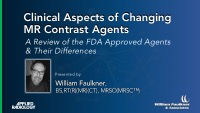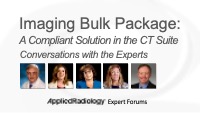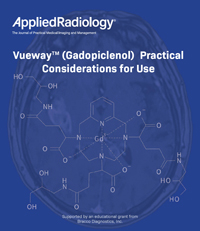Acute Stroke Imaging In The Emergency Room Environment
Authored by:
John P. Karis, MD
Expiration Date: July 31, 2026
Credits: 1.25
Format:
Webinar

The goals of Acute Stroke Imaging are to differentiate acute ischemic stroke from intracranial hemorrhage, confirm the diagnosis so patients are not treated unnecessarily, identify brain tissue that is still viable, and locate the vascular occlusion. In this education program, Dr. John Karis increases awareness of the importance of a quick, determinate diagnosis when assessing acute stoke injury. A review of the evolution of stroke treatments and clinical outcomes which are supported by the appropriate imaging modality (CT vs MRI) is discussed. When speed and accuracy are necessary, MR imaging in the ED can assist in making the diagnosis and quickly moving the patient to the appropriate treatment for improved outcomes. The recommendation of establishing an emergency room MR imaging protocol for Acute Stroke imaging is presented.
Educational Objectives
At the completion of this program, participants will be able to:
-
Understand the evolution of stroke treatments
-
Explain how to assess clinical outcomes of stroke patients
-
Discuss the clinical studies supporting interventional treatments & management of acute stroke
-
Appreciate the goals of Acute Stoke Imaging: CT vs MRI
-
Establish ED imaging recommendations for Acute Stroke and Transient Ischemic Attack patients
Supported through an unrestricted educational grant from Bracco Diagnostics, Inc.
|
Breast MRI: Patient Considerations, Abbreviated Protocols & Repeat Studies
Authored by:
Christopher Comstock,, MD, FACR
Expiration Date: July 31, 2025
Credits: 1.25
Format:
Webinar
When considering the benefits of breast screening protocols multiple challenges and considerations are involved. The potential benefits of using an abbreviated breast MRI (AB-MRI) protocol are shared with the goal of increased access and early detection of cancers. Patient clinical considerations regarding selection of GBCAs are covered as well as key influences on their selection. Chris Comstock, MD and a panel of MRI discuss the clinical considerations, patient benefits and potential use of AB-MRI for breast cancer screening.
Educational Objectives
-
Describe the benefits of breast screening protocols
-
Discuss the potential benefits of using abbreviated breast MRI (AB-MRI) as a screening tool
-
List the key influencers in the trend towards macrocyclic GBCA use
-
Summarize the current challenges and opportunities to utilizing AB-MRI for breast cancer screening
Supported through an unrestricted educational grant from Bracco Diagnostics, Inc.
|
Clinical Applications of Gadopiclenol in Pediatric MRI
Authored by:
Shreyas Vasanawala, MD, PhD
Expiration Date: March 31, 2027
Credits: 0.5
Format:
PDF

Gadolinium-based contrast agents (GBCAs) continue to advance the diagnostic value of magnetic resonance imaging (MRI). Given that children may undergo repeat exams over their lifetime, weighing the benefits of contrast with its associated risks is crucial.
In this CE-accredited program, Shreyas Vasanawala, MD, PhD, division chief of pediatric radiology at Stanford, shares his clinical experience and discusses considerations for selecting and utilizing GBCAs in pediatric MRI. With special focus on structure and relaxivity, Dr Vasanawala presents case studies that demonstrate the clinical impact of the newest GBCA, gadopiclenol.
Educational Objectives:
At the completion of this activity, participants should be able to:
-
Describe the history of GBCA use in contrast-enhanced MRI, with focus on pediatric imaging.
-
Identify key physicochemical properties that can guide the selection and use of GBCAs in children.
-
Discuss the use of gadopiclenol in pediatric clinical scenarios and its impact on patient management.
Made possible through an unrestricted educational grant from Bracco Diagnostics, Inc.
|
Clinical Aspects of Changing MR Contrast Agents
Authored by:
William Faulkner, B.S.,R.T.(R)(MR)(CT), FSMRT
Expiration Date: July 31, 2026
Credits: 1.75
Format:
Webinar

This program compares the physicochemical properties of the current FDA approved gadolinium-based MR contrast agents (GBCAs). This includes the molecular design as well as properties such as ionicity, molar concentration, relaxivity, biodistribution and excretion. Dosing considerations based on relaxivity are presented along with data from peer-reviewed publications. Stability metrics are defined and compared. Adverse events including acute, physiologic events as well as the chronic adverse reaction, NSF are discussed along with the most recent information regarding gadolinium deposition and retention.
Gadopiclenol solution for injection, 485.1 mg.mL, was approved by the FDA in Sept 2022. For a presentation about the Practical Considerations for Use of this product, please choose the online course "Gadopiclenol Injection | Practical Considerations for Use" from the list of RADU accredited programs.
Educational Objectives
At the completion of this program, participants will be able to:
-
Describe the difference between linear and macrocyclic molecules
-
Cite the least stable type of GBCA
-
Define relaxivity
-
Describe how to calculate volume of administration based on molar concentration
-
Define thermodynamic and kinetic stability
-
Cite the agents currently contraindicated in patients with eGFR below 30
-
Identify agents associated with retention of gadolinium
Supported through an unrestricted educational grant from Bracco Diagnostics, Inc.
|
Contrast Enhanced MR of the Abdomen and Pelvis
Authored by:
Kristin K. Porter, MD., Ph.D
Expiration Date: March 31, 2025
Credits: 0.5
Format:
Webinar

MR imaging of the abdomen and pelvis is performed to evaluate organs of the abdomen, such as the liver, biliary tract, kidneys, spleen, bowel, pancreas, and adrenal glands, organs of the pelvis, including the bladder and the reproductive organs; uterus and ovaries in females, and the prostate gland in males, blood vessels (including MR Angiography), and lymph nodes. MRI helps diagnose or monitor treatment for conditions such as, tumors of the abdomen or pelvis, diseases of the liver, such as cirrhosis, and abnormalities of the bile ducts and pancreas, inflammatory bowel disease such as Crohn's disease and ulcerative colitis, abnormal blood vessels and inflamed vessels (vasculitis) and a fetus in the womb of a pregnant woman.
In this educational program, Dr. Porter will focus on Intravenous Gadolinium Based Contrast Utilization in the Abdomen & Pelvis by providing a review of the ACR Appropriateness Criteria of the GI, Urological and Women’s Imaging. The clinical benefits of GBCA MRI are demonstrated by case study review. Further discussion includes a risk to benefits relationship of contrast administration and potential diagnostic alternatives.
Educational Objectives
At the completion of this program, participants will be able to:
-
Recognize when GBCA MRI is appropriate and indicated in the Abdomen & Pelvis
-
Understand the benefits of GBCA utilization in the Abdomen & Pelvis
-
Describe the risk-to-benefit relationship of contrast administration and potential, diagnostic alternatives
-
State the ACR Appropriateness Criteria of GI, Urological and Women’s imaging in MR of Abdomen & Pelvis
Supported through an unrestricted educational grant from Bracco Diagnostics, Inc.
|
Contrast Enhanced MRI: Past, Present and Future
Authored by:
Kristin K. Porter, MD., Ph.D
Expiration Date: July 31, 2026
Credits: 1.25
Format:
Webinar
In this educational program, Dr. Kristin Porter reviews the historical context of contrast enhanced MR and discusses the current recommendations for gadolinium-based contrast agents (GBCA), and briefly considers the future of contrast enhanced MR imaging.
Educational Objectives
-
Review the History of Contrast Enhanced MRI.
-
Examine the Development and Characteristics of �MR Contrast Agents.
-
Assess the Safety of MR Contrast.
-
Discuss the current recommendations for MR contrast and briefly deliberate the future of MR contrast agents.
Supported through an unrestricted educational grant from Bracco Diagnostics, Inc.
|
Contrast Media Basics: Important Considerations for the Pharmacist
Authored by:
William Faulkner, B.S.,R.T.(R)(MR)(CT), FSMRT | Kristan Harrington, MBA, R.T.(R)(MR), ARRT, MRSO | Rutu Patel, PharmD, RPh
Expiration Date: March 31, 2027
Credits: 2.5
Format:
Webinar
This two-part, on-demand webinar and accompanying digital monograph has been developed to increase overall understanding of the properties, clinical benefits, and safety considerations of iodinated and gadolinium-based contrast agents (GBCAs). The goal of this program is to fully prepare pharmacy personnel to make informed decisions regarding contrast media selection.
The complete online program has been approved for up to 2.5 Category A ARRT continuing educational credits.
Part One: Contrast Media Basics: Important Considerations for the Pharmacist
Part Two: A Pharmacist’s Guide to Gadolinium-Based Contrast Agents
Part Three: Digital Monograph: Contrast Media Basics: A Comprehensive Overview
This program was supported through an educational grant from Bracco Diagnostics, Inc.
|
Gadopiclenol | Considerations for Use in Pediatric MRI
Authored by:
Shreyas Vasanawala, MD, PhD
Expiration Date: April 30, 2027
Credits: 1.0
Format:
Webinar

This educational program featuring Dr. Shreyas Vasanawala will cover pediatric MR imaging applications using Gadopiclenol, a recently approved gadolinium-based contrast agent (GBCAs).
Following a brief review of the literature and the currently available GBCAs, Dr. Vasanawala will discuss practice considerations as they relate to MRI contrast media selection and dose administration. Additionally, Dr. Vasanawala will share several case studies demonstrating the clinical value and benefits of Gadopiclenol for patients who may present with complex pathology and/or who may be subject to repeat contrast-enhanced MRI exams over their lifetime.
Educational Objectives:
At the completion of this activity, participants should be able to:
-
Explain the properties that distinguish gadopiclenol injection from the other high relaxivity gadolinium-based contrast agents (GBCAs).
-
Employ the FDA-approved indications and clinical applications for gadopiclenol injection in pediatric patients.
-
Apply clinical considerations and dosing options for gadopiclenol administered to vulnerable patient populations who may experience repeat, lifetime dosing of a GBCA.
This program is made possible through an unrestricted educational grant from Bracco Diagnostics Inc.
|
Gadopiclenol Injection | Practical Considerations for Use
Authored by:
William Faulkner, B.S.,R.T.(R)(MR)(CT), FSMRT
Expiration Date: October 31, 2026
Credits: 1.0
Format:
Webinar

With the recent FDA approval of gadopiclenol injection, radiologists now have the choice of a macrocyclic gadolinium-based contrast agent (GBCA) with 2 – 3 times higher relaxivity at a lower standard dose as compared to other gadolinium-based contrast agents on the market.
Therefore, and because gadopiclenlol is different than other currently available GBCAs, a review of the clinical benefits of using a higher relaxivity GBCA at a lower administered dose is important. A clear understanding of relaxivity and calculation of the volume to be administered based on dosing considerations, is necessary.
In this accredited webinar, Mr. Faulkner will provide insights into the differences of the current FDA-approved GBCAs and how these differences apply to MR imaging. Following the presentation, questions from the audience were addressed during a live Q&A.
Educational Objectives:
At the completion of this activity, participants should be able to:
-
Identify the properties that distinguish gadopiclenol injection from the other high relaxivity and conventional gadolinium-based contrast agents (GBCAs).
-
Employ the FDA-approved indications and clinical applications for gadopiclenol injection.
-
Calculate and administer the proper volume dose of gadopiclenol, as compared to other conventional GBCAs.
-
Apply clinical considerations and dosing options for gadopiclenol to vulnerable patient populations who may experience repeat dosing of GBCA.
Made possible through an unrestricted educational grant from Bracco Diagnostics, Inc.
|
GBCA Contrast In Pediatrics
Authored by:
Lorna Browne, MD
Expiration Date: July 31, 2024
Credits: 1.25
Format:
Webinar

When preforming Pediatric MRI, careful clinical and safety considerations of this special patient population should be reviewed. The administration of gadolinium-based contrast agents (GBCAs) to determine the extend of disease as well as the frequency of GBCA administration over the life time of the child, can impact the type of MR contrast selected and the amount of gadolinium required to achieve diagnostic accuracy. In this accredited program, Lorna Brown. MD and a panel of MR imaging experts discuss these clinical considerations that are impacting Pediatric MRI.
Educational Objectives
-
Assess practice trends impacting Pediatric MRI
-
Review the different GBCAs chelates approved for Pediatric MR imaging (Macrocyclic vs Linear)
-
Discuss important clinical considerations and challenges of GBCAs utilization in Pediatric MRI
-
Apply best practice guidelines for GBCA administration (dosing, frequency, non-contrasted exams)
Supported through an unrestricted educational grant from Bracco Diagnostics, Inc.
|
GBCA Utilization in Body MRI Applications
Authored by:
Kevin J. Chang, MD, FACR, FSAR
Expiration Date: July 31, 2025
Credits: 1.25
Format:
Webinar
When considering body MRI, the use of GBCAs are foundational and are used in most protocols. The importance of GBCAs is documented in multiple applications for body MRI imaging. Documentation of the need for GBCA administration, sample approval, selection and processes as well as the pros and cons of various agents are considered. Case studies of GBCA choices in liver MR imaging and potential pitfalls are reviewed. Kevin Chang, MD and a panel of MRI experts discuss the clinical benefits, protocols and use of GBCAs in body MRI applications.
Educational Objectives
-
List MR body protocols that require the use of GBCA to make a complete diagnosis
-
Discuss how the need for GBCA in body imaging can be documented and justified
-
Compare and contrast the GBCA choices in liver imaging
Supported through an unrestricted educational grant from Bracco Diagnostics, Inc.
|
Imaging Bulk Package: A Compliant Solution in the CT Suite
Authored by:
Assorted Faculty
Expiration Date: March 31, 2027
Credits: 1.0
Format:
Webinar

Since the 1990’s, multi-patient contrast administration has been available in the form of the Pharmacy Bulk Package (PBP), which is still offered by several contrast vendors. The FDA required that all related Prescribing Information (PI) sheets for the PBP include specific directions for the dispensing of the contrast from the PBP container. The PI language describes withdrawing the contrast from the bottle in a suitable work area, specifically “a laminar flow hood, using aseptic techniques”. However, this method is not possible in most CT Suites, as laminar flow hoods are generally located in the Pharmacy, not the CT suite.
Therefore, during the last decade, regulators have begun to have concerns about the use of PBP. In 2009, The Joint Commission began citing imaging providers who were using PBP to fill power injector syringes in what they considered an unsuitable work area, as described in the manufacturer’s PBP guidelines for the dispensing of contrast.
This Expert Forum will review the steps taken by the contrast media industry and the FDA to develop a safe and compliant solution for multi-patent contrast administration in CT. This solution is now available as the Imaging Bulk Package (IBP) which is approved for use in the CT Suite. This panel will also share their comprehensive process for incorporating IBP into their clinical practice.
Educational Objectives:
At the completion of this activity, participants should be able to:
-
Implement Joint Commission guidelines for multi-patient contrast administration.
-
Describe the differences between Pharmacy Bulk Package (PBP) and Imaging Bulk Package (IBP) and define which is FDA approved for multi-patient use.
-
Discuss the clinical and economic benefits of multi-patient contrast administration using Imaging Bulk Package (IBP).
This program has been supported through an educational grant from Bracco Diagnostics, Inc.
|
Macrocyclic Gadolinium-Based Contrast Agents
Authored by:
William Faulkner, B.S.,R.T.(R)(MR)(CT), FSMRT
Expiration Date: March 31, 2025
Credits: 1.0
Format:
Webinar

This educational course describes the physiochemical differences between Gadolinium MR contrast agents focusing primarily on macrocyclic agents. Major topics include stability metrics, risk of NSF and current published data regarding Gadolinium retention. The information presented is based on peer reviewed literature and provides the attendee with a comprehensive review of the available Gadolinium based MR Contrast agents.
Educational Objectives
At the completion of this program, participants will be able to:
-
Describe the physiochemical properties of gadolinium-based contrast agents (GBCAs)
-
Describe the differences between a macrocyclic and linear GBCA chelate
-
State the currently available GBCAs
-
Define thermodynamic and kinetic stability constants
-
Name Group I and Group II GBCAs
-
Summarize the retention characteristics of linear and macrocyclic chelates
-
Describe any differences between the current GBCAs as it relates to acute adverse events
Supported through an unrestricted educational grant from Bracco Diagnostics, Inc.
|
MR Contrast Selection & Utilization in Pediatric & Neonatal Patients
Authored by:
Chetan C. Shah, MBBS C. Shah, MD, MBA
Expiration Date: December 31, 2026
Credits: 1.0
Format:
Webinar

In MR Imaging, a careful review of the safety criteria for the selection of a Gadolinium-based Contrast Agents (GBCAs) should be considered for pediatric and neonatal patients. The program will provide a comprehensive review of the supporting research that addresses Gadolinium selection in this special patient population. Both chronic and long-term effects of GBCAs will be discussed.
As a Pediatric Neuroradiologist, Dr. Shah is uniquely qualified to share his experience which includes a discussion of risk vs benefits, supported by practical protocols for the administration of MR contrast; including limiting the amount of contrast given to patients that may receive several lifetime doses.
Educational Objectives
-
Explain the differences between available MR contrast agents and any associated adverse events.
-
Improve clinical management decisions about when to administer MR contrast (risk vs benefit).
-
Apply FDA guidelines regarding MRI contrast agents to clinical practice.
Supported through an unrestricted educational grant from Bracco Diagnostics, Inc.
|
MRI Safety Considerations for Implants and Devices
Authored by:
Frank G. Shellock, PhD, FACC, FACR, FACSM
Expiration Date: February 28, 2026
Credits: 1.5
Format:
Webinar

This accredited program provides a comprehensive overview of MRI safety considerations for passive / active implants, and devices.
When considering patient safety during MR imaging, it is critical to assess the patient’s history and have a clear understanding of any passive and or active implants and/or devices. The ACR Manual on MR Safety states that the Radiologist is responsible for the safety of the patient undergoing the MRI Exam. They are also responsible for implementing MR Safety policies and procedures and ensuring that the facilities’ personnel adhere to them at all time. Regarding implants and devices, regular reviews and updates to the MRI safety policy should be completed.
With more than 35 years of experience in the field of MRI, the author of the best-selling textbook series, the Reference Manual for Magnetic Resonance Safety, Implants and Devices, and the creator of the internationally popular website, www.MRIsafety.com, Dr. Frank G. Shellock is uniquely qualified to present this important MRI Safety information designed for MRI Imaging professionals.
Educational Objectives
-
Name and describe the current labeling terminology for implants & devices.
-
Safely image patients with passive and active, MR Conditional implants and devices.
-
Establish a comprehensive MRI Safety protocol for imaging implants & devices.
Supported through an unrestricted educational grant from Bracco Diagnostics, Inc.
|
MRI Safety Considerations For The Radiologist
Authored by:
William Faulkner, B.S.,R.T.(R)(MR)(CT), FSMRT | Kristan Harrington, MBA, R.T.(R)(MR), ARRT, MRSO
Expiration Date: February 28, 2026
Credits: 1.5
Format:
Webinar

This accredited program provides a comprehensive overview of MRI safety including the radiologist's responsibilities and liabilities, MRI staff education and patient safety. It is designed specifically for practicing radiologists, fellows, residents, and healthcare professionals who oversee MRI services and will provide practical guidance from two respected MRI safety educators who present information on accepted safety standards of care based on the 2020 ACR Manual on MR Safety, the 2021 FDA Guidance Document, and a review of the literature.
Program Considerations: It is critical to have established MRI safety protocols and to have a clear understanding of the basics of MRI Safety. The ACR Manual on MR Safety states that the Radiologist is responsible for the safety of the patient undergoing the MRI Exam. They are also responsible for implementing MR Safety policies and procedures and ensuring that the facilities’ personnel adhere to them at all time. These MRI safety policies should be reviewed and updated annually in order to prevent patient injury.
Educational Objectives
-
Describe the difference between Level 1 & Level 2 MR personnel.
-
Differentiate and identify the ACR-designated Safety Zones.
-
Implement safety considerations for the static magnetic field, time-varying gradient magnetic fields, and radiofrequency fields.
-
Employ procedures and protocols to prevent RF-related burns and methods to manage SAR levels.
-
Manage acute and chronic gadolinium-based contrast agent adverse events.
Supported through an unrestricted educational grant from Bracco Diagnostics, Inc.
|
Neuro MRI: Why GBCA Selection Matters
Authored by:
Max Wintermark, MD
Expiration Date: July 20, 2025
Credits: 1.25
Format:
Webinar

When considering the choice of a gadolinium-based contrast agents (GBCAs) for neuro MRI, multiple factors should be reviewed as part of the selection process. Patient history, the reasons for the scan, and the clinical risks vs benefits to receiving an MR contrast are important factors. The fact that high relaxivity linear agents can potentially improve the image quality should be considered when imaging certain neurological pathologies. In this accredited program Max Wintermark, MD and a panel of MR imaging experts discuss the clinical challenges and associated imaging considerations, as well as emerging techniques impacting neuro MRI. (i.e. AI, MR contrast dose reduction & non-contrasted imaging protocols).
Educational Objectives
-
Assess practice trends impacting GBCA selection for Neuro MRI
-
Identify the clinical and patient considerations in terms of risks vs benefits of GBCA utilization
-
List the benefits of using a high relaxivity linear GBCA in neuro MRI studies
-
Discuss new and emerging techniques in the use of GBCAs in neuro MRI
Supported through an unrestricted educational grant from Bracco Diagnostics, Inc.
|
The Importance of Prompt Diagnosis of Pediatric Autoimmune Encephalitis with the Use of CE MRI
Authored by:
Michael Malinzak, M.D., Ph.D
Expiration Date: March 31, 2025
Credits: 1.0
Format:
Webinar

Autoimmune encephalitis is a difficult clinical diagnosis due to the similarities in the clinical, imaging and laboratory findings of many forms of autoimmune and infectious encephalitis.1 Many cases have no imaging findings, especially early in the course of the disease. MRI with contrast is considered the most sensitive imaging modality, and findings are present in over half of individuals.2
In this program, Dr. Maklinzak discusses the diagnosis of Autoimmune Encephalotomies using CE MR and explains how this modality can help guide acute treatment and antibody testing procedures.
1. https://www.ncbi.nlm.nih.gov/pmc/articles/PMC4712273/
2. Radiopaedia.org Autoimmune encephalitis Dr Francis Fortin and Radswiki et al.
Educational Objectives
At the completion of this program, participants will be able to:
-
Review MRI contrast considerations and imaging protocols relating to Pediatric Neuro MRI in the diagnosis of Autoimmune Encephalotomies
-
Understand the clinical imaging patterns of ADEM (acute disseminated encephalomyelitis), optic neuritis & transverse myelitis, limbic encephalitis, and MS
-
Describe the movement toward antibody diagnoses with improved prognostic value and targeted therapy
-
State how MRI findings can guide acute treatment and antibody testing
Supported through an unrestricted educational grant from Bracco Diagnostics, Inc.
|
The Proper Use of Saline During Contrast Injection
Authored by:
Richard Hallett, MD | Rutu Patel, PharmD, RPh | Stephanie Allen, MBA, RT(R)(MR), CJCP
Expiration Date: October 31, 2025
Credits: 1.5
Format:
Webinar
This 3-part on-demand program is designed to increase the participant's understanding about the oversight, management, and dispensing of saline for medical imaging. Specifically developed for pharmacists, it is intended to increase pharmacy personnel’s knowledge about the clinical benefits of saline utilization during imaging; intended to improve patient care. Radiologic technologists and others healthcare professionals that support imaging, may find this accredited program of interest.
The complete online program has been approved for up to 1.5 Category A ARRT continuing educational credits.
Part One: The Pharmacists Roles and Responsibilities
Part Two: The Clinical Benefits Of Saline Injection During CT Angiography
Part Three: Digital Monograph: Overview and Resources
This program was supported through an educational grant from Bracco Diagnostics, Inc.
|
Vueway™ (Gadopiclenol): Practical Considerations for Use
Authored by:
William Faulkner, B.S.,R.T.(R)(MR)(CT), FSMRT
Expiration Date: April 30, 2027
Credits: 0.75
Format:
PDF

Prior to 2023, six extracellular fluid magnetic resonance imaging (MRI) contrast agents were available in the US: ProHance® (gadoteridol), Gadavist® (gadobutrol), Dotarem® (gadoterate meglumine; Clariscan™ (gadoterate meglumine); Omniscan™ (gadodiamide); and MultiHance® (gadobenate dimeglumine). These gadolinium-based contrast agents (GBCAs) vary with respect to chelate structure (ionic vs nonionic; macrocyclic vs linear), molar concentration (the number of Gd molecules per mL), and relaxivity.
With decades of use, these agents were demonstrated to be quite safe; however, since 2006, concerns about the safety of GBCAs have come to light, particularly with regard to the less stable (linear, nonionic) agents. Specifically, nephrogenic systemic fibrosis (NSF) and Gd retention were seen more readily with the use of these less-stable agents. It became apparent that a macrocyclic, high-relaxivity GBCA would be ideal, optimizing patient safety without compromising image quality.
In 2023, the US Food and Drug Administration approved Vueway™ (gadopiclenol) injection, a macrocyclic, high relaxivity agent that represents a significant advancement in terms of efficacy and safety. This paper compares the properties, mechanism-of-action, dosing, efficacy, and safety of the currently available GBCAs to the new agent Vueway.
This program has been supported through an educational grant from Bracco Diagnostics, Inc
|